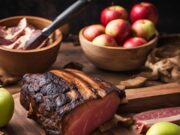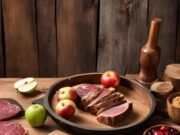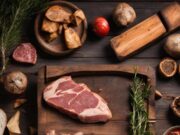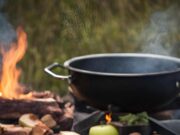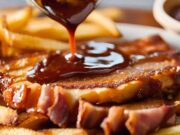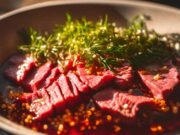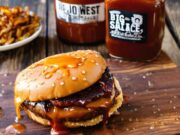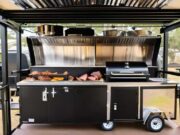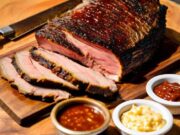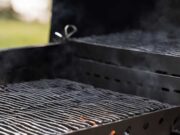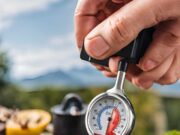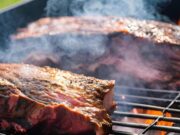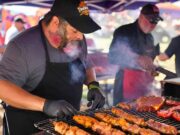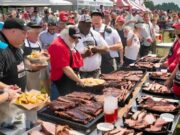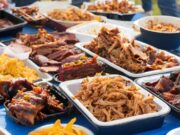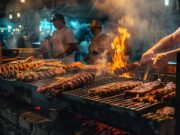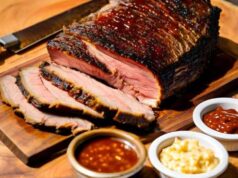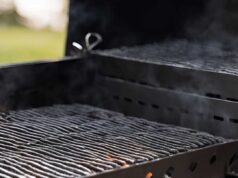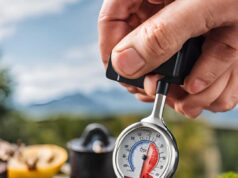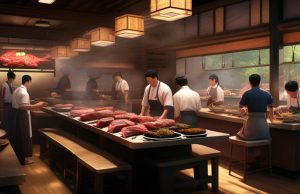- Key Takeaways:
- The Fundamentals of Heat Transfer in Cooking
- The Importance of Temperature Control
- Understanding Time: How Long Should You Cook?
- Meat Anatomy: Best Cuts for Low and Slow Cooking
- The Role of Moisture in Low and Slow BBQ
- The Maillard Reaction: Enhancing Flavor
- Seasoning and Marinades: Preparing Meat
- Frequently Asked Questions
Low and slow BBQ is not merely a cooking technique; it is an art form that elevates simple cuts of meat into tender, flavorful masterpieces.
This method emphasizes the critical elements of temperature and time. You will learn how heat transfer functions in cooking, the significance of precise temperature control, and the optimal meat cuts that achieve that perfect melt-in-your-mouth texture.
Additionally, you will explore the importance of moisture, the Maillard reaction for flavor enhancement, and how to prepare your meat using the right seasonings and marinades.
Engage in this flavorful journey to master the science of low and slow BBQ.
Key Takeaways:
- Low and slow cooking involves cooking meat at a low temperature for a longer period of time, resulting in tender and flavorful BBQ.
- Temperature control is crucial in achieving perfect BBQ – too high and the meat will dry out, too low and it won’t cook properly.
- Understanding the science behind low and slow BBQ, including heat transfer, moisture, and the Maillard reaction, can help you become a BBQ master.
The Fundamentals of Heat Transfer in Cooking
Understanding the fundamentals of heat transfer is crucial for anyone looking to perfect their BBQ skills, as it involves the conversion of energy into heat that cooks the meat.
By exploring the different modes of heat transfer—conduction, convection, and radiation—you can enhance your techniques and achieve exceptional results.
In grilling, heat is rapidly transferred through direct contact with the hot grill grates, resulting in a delightful sear and crispy exterior. On the other hand, convection takes place during smoking, where hot air circulates around the meat, promoting even cooking and infusing it with smoky flavors.
Sous vide cooking utilizes precise temperature control by leveraging water’s ability to conduct heat evenly, ensuring that meats are cooked to perfection while retaining their juiciness. Embracing the science behind these methods can significantly elevate your grilling skills to new heights.
The Importance of Temperature Control
Temperature control is a critical component of successful BBQ, as maintaining the ideal temperature ensures that meat is cooked thoroughly while enhancing its flavor and texture.
Utilizing a high-quality thermometer is essential for accurately monitoring cooking temperatures. This tool allows you to understand how high heat can create a beautiful sear, while low-and-slow methods provide the necessary time for collagen and fats to break down, resulting in tender meat.

Different types of meat have specific temperature requirements: for example, poultry should reach an internal temperature of 165°F, while beef, lamb, and pork should ideally be cooked to at least 145°F.
Undercooking poses a risk of foodborne illnesses, while overcooking can dry out the meat and diminish its natural juices and flavor. Therefore, vigilance in temperature control is crucial for ensuring safe and delicious BBQ.
Understanding Time: How Long Should You Cook?
Understanding how long to cook each cut of meat is crucial when practicing low and slow BBQ. Different meats require varying cook times to achieve optimal tenderness and flavor.
You can further explore the nuances of cooking times through various preparation methods such as smoking, grilling, and sous vide. Smoking typically requires longer durations due to the lower temperatures involved, while grilling generally cooks meat at higher heat for shorter timeframes. Sous vide, on the other hand, offers precise temperature control, allowing you to achieve perfectly tender meats cooked to your desired doneness over extended periods.
Factors such as the thickness of the cut, the type of meat, and your personal preferences for doneness—whether rare, medium, or well-done—are all critical in determining not only the cooking timeline but also the overall success of your culinary endeavor.
Meat Anatomy: Best Cuts for Low and Slow Cooking
Understanding the anatomy of meat is essential for determining which cuts are best suited for low and slow cooking, making it imperative for BBQ enthusiasts to familiarize themselves with the characteristics of various cuts.
Cuts such as pork shoulder, beef brisket, and ribs excel in this cooking method due to their rich marbling and higher collagen content, which contribute significantly to flavor and moisture. When these tougher cuts are cooked at lower temperatures over extended periods, the collagen and connective tissues gradually break down into gelatin, enhancing the meat’s texture.
This slow cooking process not only improves tenderness but also allows the flavors to fully permeate the meat, resulting in juicy, melt-in-your-mouth bites. Selecting cuts that are rich in intramuscular fat ensures a delectable and succulent outcome that can elevate any BBQ gathering.
The Role of Moisture in Low and Slow BBQ
Moisture is a critical factor in low and slow BBQ, as it directly influences the juiciness and overall quality of the meat during cooking.
To ensure that the meat emerges from the grill succulent and bursting with flavor, several strategies can be employed. One effective method is brining, which involves soaking the meat in a salty solution. This process allows the meat to absorb moisture and enhance its flavor. Marinating is another popular technique, often utilizing acidic ingredients such as vinegar or citrus juice, resulting in a deliciously tender end product.
Utilizing water pans in smokers can create a humid cooking environment, which helps prevent the meat from drying out during the lengthy smoking process. When these techniques are combined with proper cooking methods, such as low-temperature smoking and allowing adequate resting time, they significantly contribute to moisture retention and elevate the overall quality of barbecue preparations.
The Maillard Reaction: Enhancing Flavor
The Maillard reaction is a critical chemical process that occurs during cooking, significantly enhancing the flavor and aroma of BBQ meats, making it a vital component of the cooking process.
This intricate interaction between amino acids and reducing sugars happens when food is subjected to high heat, resulting in the desirable deep brown color and a rich, umami-packed flavor profile. Understanding this reaction can elevate your backyard cooking experience; achieving optimal results depends heavily on careful seasoning prior to cooking and the implementation of appropriate techniques.
Starting with high heat can create an exceptional crust through rapid caramelization, followed by transitioning to low-and-slow methods to tenderize the meat, thereby enhancing flavors even further. The key lies in balancing these techniques to effectively stimulate the Maillard reaction.
Seasoning and Marinades: Preparing Meat
Seasoning and marinades are essential components of your BBQ preparation, as they provide depth of flavor and enhance the overall dining experience. They do more than just coat the meat; they infuse it with bold tastes and aromatic profiles that can elevate a simple dish into a memorable feast.
In crafting these flavorful concoctions, the careful selection of spices and herbs is pivotal. For instance, robust spices like cumin or paprika can create a hearty backdrop, while fresh herbs like rosemary and thyme contribute brightness to the mix. Additionally, acids from ingredients such as vinegar or citrus juices help to tenderize the protein, allowing flavors to penetrate more deeply.
To truly maximize flavor absorption, it is crucial to allow ample time for the marinade to work its magic—ideally several hours or even overnight. This ensures that every bite is a burst of deliciousness. Understanding the balance between seasoning and marination can elevate any BBQ dish to new heights.
Frequently Asked Questions
What is the science behind low and slow BBQ?
The science behind low and slow BBQ is based on the principles of heat and time. By cooking meat at a low temperature for a longer period of time, the tough collagen in the meat breaks down, resulting in a tender and flavorful dish.
Why is temperature important in low and slow BBQ?
The temperature used in low and slow BBQ is crucial as it determines the rate at which the collagen in the meat breaks down. Too high of a temperature can result in tough and dry meat, while too low of a temperature may not fully break down the collagen.
What is the ideal temperature for low and slow BBQ?
The ideal temperature for low and slow BBQ is typically between 225-250°F (107-121°C). This allows for the collagen to break down slowly and evenly, resulting in tender and juicy meat.
How does time factor into low and slow BBQ?
Time is an important component in low and slow BBQ as it allows for the collagen to fully break down and for the flavors to develop. The longer the cooking time, the more tender and flavorful the meat will be.
What types of meat are best for low and slow BBQ?
Meats with a higher amount of collagen, such as beef brisket and pork shoulder, are best for low and slow BBQ. These cuts require longer cooking times to fully break down the collagen and become tender.
Can I use a gas grill for low and slow BBQ?
While it is possible to use a gas grill for low and slow BBQ, it is not ideal as gas grills often have difficulty maintaining a low and steady temperature. Charcoal or wood smokers are the preferred method for low and slow BBQ as they allow for better temperature control.



